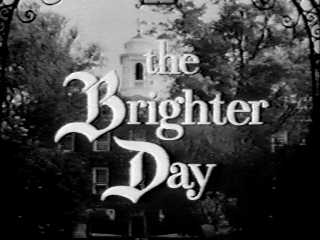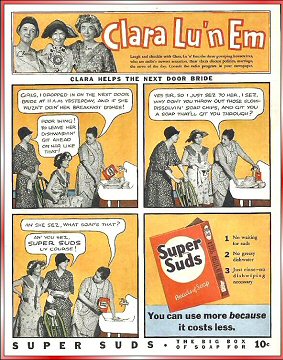
The Brighter Day is an American daytime soap opera which aired on CBS from January 4, 1954, to September 28, 1962. Originally created for NBC Radio by Irna Phillips in 1948, the radio and television versions ran simultaneously from 1954–56. Set in New Hope, Wisconsin, the series revolved around Reverend Richard Dennis and his four children, Althea, Patsy, Babby and Grayling.

Painted Dreams is an American radio soap opera that premiered on WGN radio, Chicago, on October 20, 1930 and last aired in July 1943. It is widely considered by scholars of the genre to be the first daytime soap opera or drama-by-installment serial. The first to be broadcast in daytime over a radio network would be Clara, Lu 'n Em, two years later.

Backstage Wife is an American soap opera radio program that details the travails of Mary Noble, a girl from a small town in Iowa who came to New York seeking her future.

Anne Hummert was the leading creator of daytime radio serials or soap opera dramas during the 1930s and 1940s, responsible for more than three dozen series.
Just Plain Bill was a 1932-1955 15-minute American radio drama program heard on CBS Radio and NBC Radio. It was "a story of people just like people we all know."
David Ford Bond was an American radio personality.
David Harum; A Story of American Life is a best-selling novel of 1898 by Edward Noyes Westcott.

Clara, Lu, 'n Em is a radio soap opera, which first aired on June 16, 1930, over WGN-AM Chicago, Illinois. The show was picked up by the NBC Blue radio network and premiered at 10:30 p.m. Eastern Time on January 27, 1931. Thus, it became the first nationally broadcast radio soap opera. When Clara, Lu 'n Em was moved to a regular daytime time slot on February 15, 1932, it became the first networked daytime soap opera.

Big Sister was a daytime radio drama series created by Lillian Lauferty and broadcast on CBS from September 14, 1936, to December 26, 1952. It was sponsored by Lever Brothers for Rinso until 1946 when Procter & Gamble became the sponsor.
Edward Frank Hummert, Jr., professionally known as Frank Hummert and sometimes credited as E. Frank Hummert, was an American advertising agent originally but was best known for writing/producing episodes of nearly 100 daytime/primetime radio dramas and soap opera serials between the 1930s and the 1950s.
Tarzan is a generic title that can be applied to any of three radio jungle adventure programs in the United States. Two were broadcast in the 1930s and one in the 1950s.

Joyce Jordan, M.D. is a 1938-1955 radio soap opera in the United States. It was broadcast on ABC, CBS and NBC at various times during the era of old-time radio.

Alias Jimmy Valentine is an old-time radio crime drama in the United States. It was broadcast on NBC-Blue January 18, 1938 - February 27, 1939.

Brenda Curtis is an old-time radio soap opera in the United States. It was broadcast on CBS from September 11, 1939 to January 19, 1940.

Chick Carter, Boy Detective is a 15-minute American old-time radio juvenile crime drama. It was carried on the Mutual Broadcasting System weekday afternoons from July 5, 1943 to July 6, 1945.

Front Page Farrell is an American old-time radio program that was broadcast on Mutual from June 23, 1941 to March 13, 1942, and on NBC from September 14, 1942, to March 26, 1954. The episodes broadcast on Mutual originated at WOR, making the program the first live serial that Mutual broadcast from New York City.
Hop Harrigan is an American old-time radio juvenile adventure program. It was broadcast on ABC from August 31, 1942, until August 2, 1946, and on Mutual from October 2, 1946, until February 6, 1948. General Foods began sponsoring the program on October 2, 1944; it had previously been unsponsored.
Hilltop House is an American old-time radio soap opera. It debuted on November 1, 1937, was replaced by a spinoff, then was re-launched twice, with its final episode coming on July 30, 1957.
The Parker Family was an American radio soap opera broadcast from 1939 to 1944.

The Story of Mary Marlin is an American soap opera radio program. It was broadcast from October 3, 1934, until April 12, 1945, and returned from September 24, 1951, until April 11, 1952. After 1937 it was among the highest-rated soap operas. A version was also broadcast in Australia in 1959-1960.












